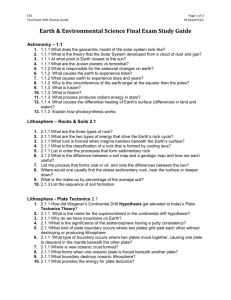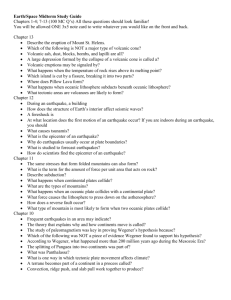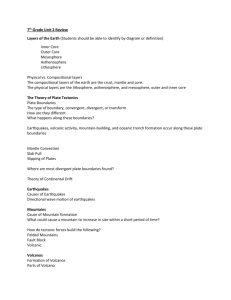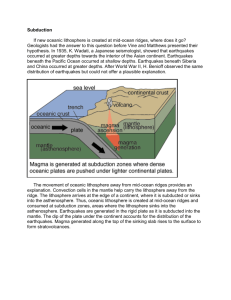Earth & Environmental Science Final Exam Study Guide
advertisement
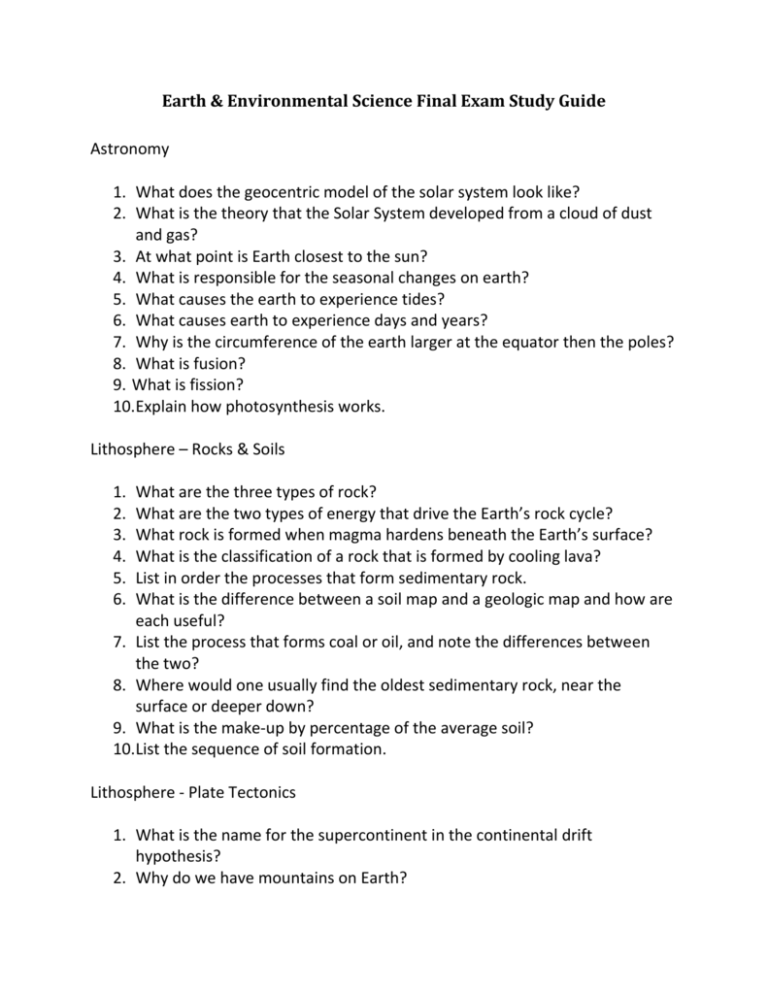
Earth & Environmental Science Final Exam Study Guide Astronomy 1. What does the geocentric model of the solar system look like? 2. What is the theory that the Solar System developed from a cloud of dust and gas? 3. At what point is Earth closest to the sun? 4. What is responsible for the seasonal changes on earth? 5. What causes the earth to experience tides? 6. What causes earth to experience days and years? 7. Why is the circumference of the earth larger at the equator then the poles? 8. What is fusion? 9. What is fission? 10.Explain how photosynthesis works. Lithosphere – Rocks & Soils 1. 2. 3. 4. 5. 6. What are the three types of rock? What are the two types of energy that drive the Earth’s rock cycle? What rock is formed when magma hardens beneath the Earth’s surface? What is the classification of a rock that is formed by cooling lava? List in order the processes that form sedimentary rock. What is the difference between a soil map and a geologic map and how are each useful? 7. List the process that forms coal or oil, and note the differences between the two? 8. Where would one usually find the oldest sedimentary rock, near the surface or deeper down? 9. What is the make-up by percentage of the average soil? 10.List the sequence of soil formation. Lithosphere - Plate Tectonics 1. What is the name for the supercontinent in the continental drift hypothesis? 2. Why do we have mountains on Earth? 3. What kind of plate boundary occurs where two plates grid past each other without destroying or producing lithosphere 4. What type of boundary occurs where two plates move together, causing one plate to descend in the mantle beneath the other plate? 5. Where is new oceanic crust formed? 6. What forms when one oceanic plate is forced beneath another plate? 7. What boundary destroys oceanic lithosphere? 8. What provides the energy for plate tectonics? 9. The Hawaiian Islands were formed when the Pacific Plate moved over what unique feature? 10.What layers of Earth make up the lithosphere? Lithosphere – Earthquakes 1. 2. 3. 4. 5. What are earthquakes usually associated with? What is a travel time graph be used for? What instrument records earthquake waves? Where is the epicenter of an earthquake versus the focus? Name the smaller earthquakes that can precede the actual earthquake versus those that come after. 6. Why do earthquakes often cause damaging fires? 7. What causes a tsunami? 8. What is the amount of shaking caused by an earthquake at a given location? 9. What is a fault? 10.Which seismic waves are the most destructive? 11.What is the minimum number of seismic stations needed to determine the location of an epicenter? 12.What is the earthquakes source called? 13.What is the scale most widely used by scientist to measure earthquakes? 14.What seismic waves travel the fastest? Slowest? Lithosphere – Volcanoes 1. What is a caldera? 2. What is a lahar? 3. How does a volcanic eruption affect the atmosphere? 4. What are the particles of rock, lava, ash & other volcanic fragments blown from the vent of a volcano? Hydrosphere – Surface and Ground Fresh Water 1. What zone is ground water found in underground? 2. What are the permeable rock layers or sediments that transmit groundwater freely? 3. Why do we have water shortages? 4. What are the laws that protect our water supply? 5. What types of events can pollute groundwater today? 6. What types of events pollute our surface water today? Hydrosphere – Oceanography 1. Approximately how much of Earth’s surface is covered by land versus water? 2. How does the presence of ocean versus land affect the temperature of Earth’s Hemispheres? 3. Where does seafloor spreading occur? 4. What process uses light energy to convert water & carbon dioxide into energy-rich, glucose molecules? 5. What is the complex feeding relationship among a number of different organisms? 6. List at least 3 reasons why we have beach erosion in North Carolina. 7. Name three environmental concerns affecting our oceans today & their causes. Atmosphere - Weather and Climate 1. What is the form of oxygen that combines three oxygen atoms into each molecule? 2. What are isobars? What happens when they are close together? Far apart? 3. Where is air pressure exerted and how does it change as you move up through Earth’s atmosphere? 4. What are isotherms? 5. What is the ratio of air’s water vapor content to its capacity to hold water vapor at the same temperature? 6. What are maritime air masses versus continental? 7. What is the boundary that separates different air masses? 8. Which type of front is shown by a line with triangular points versus semicircles on one side? 9. How do you decide which side to put the semicircles or triangles? 10.When you see a wind flag, how does it help you determine the direction of the wind and how is this direction labeled? 11.Why are we concerned about climate change today when we have had climate changes in the past? Natural Resources & Global Issues 1. 2. 3. 4. What are some examples of renewable resources? What defines a renewable resource? What are some examples of nonrenewable resources? What type of energy resource could replace the dwindling petroleum supplies? 5. What are the advantages of solar energy? 6. What is the fuel source in nuclear reactors? 7. How does nuclear fission produce energy? 8. What produces hydroelectric power? 9. What are some examples of non-point source pollution for fresh water? 10.What amount of Earth’s total water supply is usable fresh water? 11.What is the function of the atmosphere’s ozone layer and where is it found? 12.What does the greenhouse gas carbon dioxide help the atmosphere do? 13.Know the pros and cons of obtaining energy from various sources such as Natural Gas, Coal, Nuclear, Solar, Wind, or Hydroelectric, Oil, biomass, etc. 14. How might we meet our energy needs of the future? 15.What does a sustainable future mean?
